Understanding the Editorial
An editorial is a critical component of your ezine, offering the opportunity to set the tone and engage readers with your viewpoint on current issues. It combines factual analysis with insights to guide reader opinions.
Research and Knowledge
Editorial writing is rooted in research and knowledge. The first step involves conducting extensive research using reliable sources. Begin by identifying credible materials such as books, academic journals, expert interviews, and verified online platforms. The importance of thorough research cannot be overstated, as it forms the backbone of your editorial. Delving into various sources provides a richer understanding of all facets of the issue at hand and aids in presenting well-rounded arguments.
Accuracy and depth are your allies in this process. Ensuring your writing is informed by reliable data instills confidence in your readership regarding your interpretations. The goal is to provide a narrative that not only highlights your perspective but also justifies it with irrefutable facts. By setting this foundation, you can establish the credibility necessary for influencing public opinion.
Developing a Clear Thesis
Central to a powerful editorial is a clear thesis, which articulates your main argument or stance on a particular issue. The thesis serves as the backbone of your entire writing, framed concisely and acting as the focal point around which your arguments revolve.
Crafting this statement involves clarity and conviction. The thesis needs to both introduce the subject matter and reflect your position effectively, offering readers insight into what to expect as they read further. A well-articulated thesis not only guides the audience but also keeps your writing focused and coherent, preventing digressions that could dilute your message.
Structured Argumentation
The structure of your editorial is essential in maintaining a logical flow that is easy for readers to follow. Begin by introducing your thesis clearly, outlining the framework within which you will present your arguments.
Following this, provide evidence to back up your claims. The evidence should be presented in a way that is both logical and persuasive, using statistics, expert opinions, case studies, and other forms of factual data. Efficient use of evidence allows you to delve into the implications of the issue, examining different sides while reinforcing your position.
In concluding this structured argumentation, reinforce your stance and summarize the key points presented throughout the editorial. This closing segment should weave together the various pieces of evidence you’ve presented, illustrating how they cumulatively support your initial thesis.
Balancing Objectivity and Persuasion
A successful editorial adeptly balances objectivity with persuasion. Writing objectively means that your arguments are supported by verified facts and reliable data while avoiding baseless assertions. This objective framework serves as a platform for introducing persuasive elements.
To effectively persuade, emphasize the importance of your viewpoint through the strategic use of relevant examples and real-world implications. Highlight potential consequences or benefits related to the issue, thus engaging readers by showcasing what is at stake. Even though your aim is to convince, maintaining a professional tone rooted in facts enhances your credibility, making your argument more compelling.
Concluding Thoughtfully
The conclusion of an editorial is as critical as its introduction and body. It is your last opportunity to leave a strong impression on the audience. Therefore, it’s important to conclude thoughtfully.
Revisit your thesis within this final section, reflecting on how the evidence you presented throughout your piece upholds your stance. This moment of returning to your thesis should not merely repeat it; instead, it should illustrate how your arguments reinforce your position, offering a rounded summation of the discussion.
Additionally, cast an eye towards the future. A strong conclusion often proposes potential actions or reflections for the reader. Such suggestions can encourage further dialogue or contemplation about the issue, potentially even inspiring your readers to explore further on their own.
To cultivate your skills further, exploring resources such as writing workshops and guides can be beneficial. These resources provide additional insights and techniques that can be employed to enhance the impact and efficacy of your editorial writing.
For additional writing tips, consider exploring resources like writing guides and workshops.
Visit this writing center for more insights.

